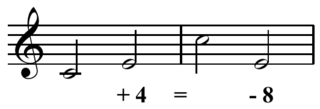Top Qs
Timeline
Chat
Perspective
Interval class
Distance between unordered pitch classes From Wikipedia, the free encyclopedia
Remove ads
In musical set theory, an interval class (often abbreviated: ic), also known as unordered pitch-class interval, interval distance, undirected interval, or "(even completely incorrectly) as 'interval mod 6'" (Rahn 1980, 29; Whittall 2008, 273–74), is the shortest distance in pitch class space between two unordered pitch classes. For example, the interval class between pitch classes 4 and 9 is 5 because 9 − 4 = 5 is less than 4 − 9 = −5 ≡ 7 (mod 12). See modular arithmetic for more on modulo 12. The largest interval class is 6 since any greater interval n may be reduced to 12 − n.

Remove ads
Use of interval classes
The concept of interval class accounts for octave, enharmonic, and inversional equivalency. Consider, for instance, the following passage:
(To hear a MIDI realization, click the following: ⓘ
In the example above, all four labeled pitch-pairs, or dyads, share a common "intervallic color." In atonal theory, this similarity is denoted by interval class—ic 5, in this case. Tonal theory, however, classifies the four intervals differently: interval 1 as perfect fifth; 2, perfect twelfth; 3, diminished sixth; and 4, perfect fourth.
Remove ads
Notation of interval classes
The unordered pitch class interval i(a, b) may be defined as
where i⟨a, b⟩ is an ordered pitch-class interval (Rahn 1980, 28).
While notating unordered intervals with parentheses, as in the example directly above, is perhaps the standard, some theorists, including Robert Morris,[1] prefer to use braces, as in i{a, b}. Both notations are considered acceptable.
Remove ads
Table of interval class equivalencies
See also
References
Sources
Further reading
Wikiwand - on
Seamless Wikipedia browsing. On steroids.
Remove ads


